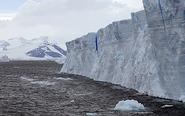
A review of the research conducted in the last decade by Eugene Domack, the Joel W. Johnson Family Professor of Geosciences, comprises a notable portion of Antarctica, An Intimate Portrait of the World’s Most Mysterious Continent, published recently by Bloombury Press, UK. The book was written by Gabrielle Walker, a consultant to New Scientist and a regular BBC contributor who has taught at both Princeton and Cambridge Universities. She has been on five Antarctic assignments for Nature magazine and the BBC.
Walker accompanied Domack on one of his Antarctic expeditions and wrote about his research related to the Larsen B ice shelf collapse. In 2005, Domack provided evidence that the break-up of the ice shelf was caused by a combination of long-term thinning (by a few tens of meters) over thousands of years and short term (multi-decadal) cumulative increases in surface air temperature that have exceeded the natural variation of regional climate during the Holocene period (the last 10,000 years since the end of the last Ice Age). He and his colleagues attributed the collapse to the effects of climate warming in the Antarctic Peninsula, which is more pronounced in that region than elsewhere in Antarctica or the rest of the world.
A review of the book in The Guardian included this passage, “The Larsen B Ice Sheet in West Antarctica disintegrated spectacularly in 2002 and this event is a key indicator of anthropogenic climate change. The ice sheet had remained intact for at least 10,000 years. Where will the next crack open? We are all anxious Antarctic watchers now, and Walker's book is the essential primer.”
